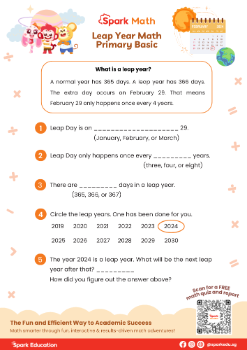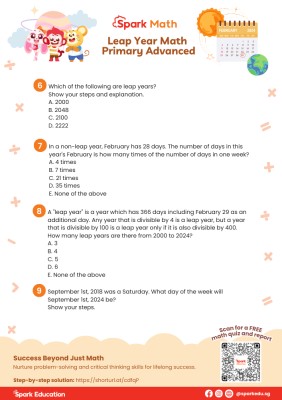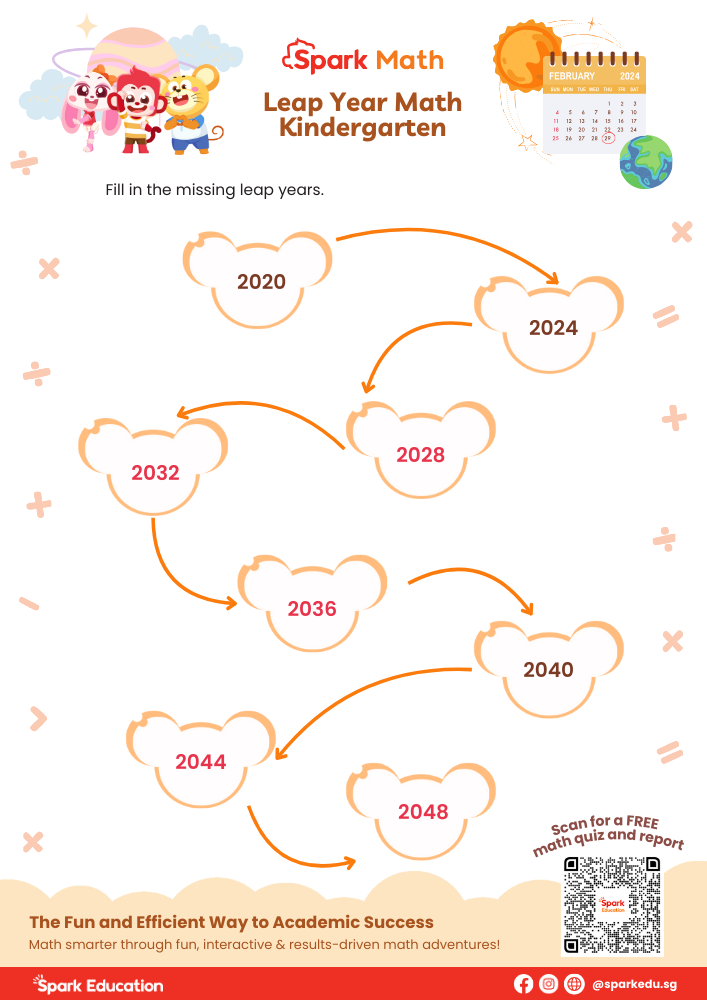Counting down for our once-in-four-years Leap Day for this Thursday! In our previous article, we explored the science and math principles behind leap years. Now, it’s time to solve some math problems related to leap years.
Whether your child is just starting to learn mathematical concepts or is already a seasoned Math Olympiad problem solver, these free Spark Math festive worksheets are sure to spark curiosity and excitement.
Understanding Leap Years
Before we leap into the math problems, let’s quickly recap what leap years are. A leap year occurs every four years to keep our calendar in sync with the solar year, which is slightly longer than our typical 365-day calendar year. During a leap year, an extra day is added to February, making the month 29 days instead of the usual 28.
Free Worksheets for Leap Year Fun
Understanding leap years shows how math impacts our world. Our Spark Math teachers have created free worksheets tailored to children of different math skill levels. These worksheets feature a range of leap year math problems aimed at improving your child’s mathematical reasoning, critical thinking, and problem-solving skills.
For Kindergarten (Leap Year Skip Counting)
This worksheet is designed to help kindergarten students practice counting by four, enhancing their number sense, and pattern recognition skills.

For Primary (Basic Leap Year Math Problems)
Problems 1-5 are tailored for primary school students, focusing on counting, calendar skills, reading comprehension, and real-life applications.

For Primary (Advanced Math Problems)
Get ready for an extra dose of challenge! Problems 6-9 in the Advanced section draw inspiration from the mock papers of the International Junior Math Olympiad. These questions are perfect for both primary school students who are eager to put their critical thinking and problem-solving skills to the test.

Check out our Spark Math Competition Programme to see how our Spark Math teacher guide your child on the path to becoming math champions!
What Concepts Do The Spark Math Leap Year Worksheets Teach?
Number Sense and Counting by Four
Counting leap years involves basic counting skills. Since leap years occur every four years, children learn to count by fours to identify leap years. This reinforces their ability to count sequentially and identify multiples of four.
Pattern Recognition
Identifying leap years involves recognising patterns in the calendar. Children learn to identify the recurring pattern of leap years and the exceptions (such as years divisible by 100 but not by 400). This skill is crucial in mathematics and lays the groundwork for more advanced topics like algebra and geometry.
Calendar Calculations
The worksheet also provides practice in calendar calculations, as students work with dates and years to identify leap years accurately. This helps them become more proficient in manipulating and interpreting calendar information.
Problem-Solving and Critical Thinking
Leap year and calendar calculation also involves problem-solving and critical thinking skills. To determine future or past leap years, children need to calculate the number of leap years within a certain time frame. This encourages them to apply their math knowledge in different contexts and make logical deductions.
Real-World Application
By engaging with leap year calculations, students see the real-world application of mathematical concepts. They understand why leap years are necessary and how they impact our calendar system.
Answer Key and Solutions
Now, check out the answer key and step-by-step solutions for the Leap Years Spark Math worksheets here.
Leap Year Skip Counting
- Identify the starting point.
- Identify the leap year (+4) pattern.
- Fill in the missing leap years.
- Double check by counting backwards.

Primary (Basic Math Problems)
1. February
2. four
3. 366
4. 2020, 2024, and 2028
5. 2028
Method: Add 4 years to 2024.
Primary (Advanced Math Problems)
Problems 6 – 9 are inspired by the International Junior Math Olympiad competition. Check out our Spark Math Competition Programme to see how our Spark Math teacher guide your child on the path to becoming math champions!
6. To calculate whether a year is a leap year, you can use the following steps:
A – 2000:
– Divisible by 4? Yes
– Divisible by 100? Yes
– Divisible by 400? Yes
So, 2000 is a leap year.
B – 2048:
– Divisible by 4? Yes
– Divisible by 100? No
So, 2048 is a leap year.
C – 2100:
– Divisible by 4? Yes
– Divisible by 100? Yes
– Divisible by 400? No
So, 2100 is not a leap year.
D – 2222:
– Divisible by 4? No
So, 2222 is not a leap year.
Therefore, among the given options, only 2000 and 2048 are leap years. Hence, the correct answers are A and B.
7. Number of times = Total days in February ÷ Days in a week
In a non-leap year, there are 28 days in February, so the number of times:
= 28 ÷ 7
= 4
So, the number of days in February in a non-leap year is 4 times the number of days in one week.
However, this year (2024) is a leap year. There are 29 days in February, so the number of times:
= 29 ÷ 7
= 4 (with remainder 1)
Hence, the correct answer is technically E. None of the above.
8. First, list out all the years from 2000 to 2024 that are divisible by 4:
= 2000, 2004, 2008, 2012, 2016, 2020, and 2024.
Then, double check the list against the special rule for century leap years:

So, there are 7 leap years from 2000 to 2024. Hence, the correct answer is E. None of the above.
9. To find out the day of the week for 1st September 2024, we can utilise the fact that there are exactly 7 days in a week.
Number of weeks in a non-leap year
= 365 ÷ 7
= 52 (with remainder 1)
Number of weeks in a leap year
= 366 ÷ 7
= 52 (with remainder 2)
Therefore, every non-leap year, the day of the week advances by 1 day, and every leap year, it advances by 2 days.
From 1st September 2018, to 1st September 2024, there are 6 years in total. Among these, there are 2 leap years (2020 and 2024) and 4 non-leap years.
So, the total number of days that the day of the week advances within the given period, can be calculated as follows:
Number of days advanced in non-leap years
= 4 non-leap years × 1 day
= 4 days
Number of days advanced in leap years
= 2 leap years × 2 days
= 4 days
Total number of days advanced
= 4 days (leap years) + 4 days (non-leap years)
= 8 days
Since there are 7 days in a week, advancing by 8 days from a Saturday gives us a Sunday.
Therefore, 1st September 2024, will be Sunday.
How Spark Math Teaches Math?
Spark Math by Spark Education is designed to help K2-P6 children develop strong numeracy skills, master heuristic strategies, and excel in Mathematics. It goes beyond the Singapore MOE Math Syllabus, introducing students to advanced problems found in international competitions and real-life scenarios.
Through dual-interface technology, Spark Math teachers can interact with students in real-time. They use gamification and animated content to ensure engaged, active learning while reinforcing advanced math concepts.
With Spark Math, your child will receive both physical and digital textbooks, workbooks, and math manipulatives, creating an effective blended learning experience conveniently at home. Our parent app also provides a one-stop solution for managing the class schedules and monitoring your child’s learning progress.
Ready to see the difference Spark Math can make for your child? Try a FREE online math test and receive a complimentary report to experience firsthand how Spark Math can help your child succeed in mathematics!




